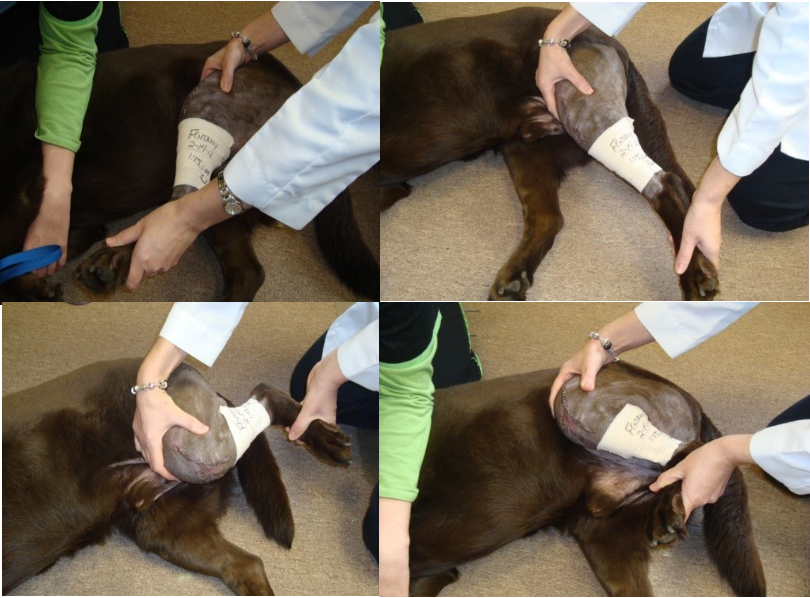
The Therapy on dog exercises to help your dog recover After Cruciate Ligament Repair as much use of the operated leg as possible!
- The Physical Therapy On dog for the first 14 days after surgery (starting on day 1)
a. Cold Therapy: Helps soothe pain and decrease inflammation
Use ice or frozen peas or corn (not a “cold pack” – they aren’t cold enough!) and apply directly to skin or in a pillowcase, nothing thicker.
Ensure to cool all knee areas – the outside where the incision is, the front, and the inside.
Ice for 15 minutes at least 3-4 times a day and after PROM.
b.Therapy On dog for Passive Range of Motion (PROM): Stimulates blood flow, speeds healing and prevents muscle atrophy.
Move the entire leg through the motion of pedalling a bike with one hand just above the foot and the other hand above the incision. Repeat 15-20 times 2-3 times daily. Take your pet just to their maximum comfort level, but not beyond. See a video demonstration under Pet Education Videos.
c. Massage: Stimulates blood flow and prevents scar tissue within muscles.
Apply deep pressure to the quadriceps and hamstring muscles (large muscle groups at the front and rear of the thigh). Start at the knee and move up toward the hip. Massage for 2-3 minutes before and after PROM.
d. Walking: Helps maintain strength.
SLOW and CONTROLLED walking (not trotting) on a leash 5-10 minutes twice a day. Walk on level surfaces, avoiding hills and steps at first.
Therapy On dogWeeks 2-4
a. Continue PROM and massage.
b. Increase length of walks gradually to 15-20 minutes twice daily by week 4. Stay slow and controlled!
c. Ice after PROM and walks.
Therapy On dogWeeks 5-8
a. Continue slow, controlled leash walks. Gradually increase to 20-30 minutes per walk. Add the following while walking to build strength:
1. Walk your dog in a figure 8 pattern to the left and right. Start with a prominent figure 8 and walk the pattern 5 times in one direction before changing to the other direction. Over 3-4 weeks, gradually tighten the figure 8 and switch directions more frequently.
2. Do sit-to-stand exercises. Stand your dog alongside a wall with the operated leg against the wall and ask the dog to sit and then to stand several seconds later. Try to prevent your dog from walking forward when standing up to make this more difficult. Start with 3-4 repetitions 2-3 times a day and build to 10 reps.
b. Continue PROM, massage, and ice.
- After the second month, add some of the following:
a. Continue all above exercises for strength and range of motion.
b. Add uphills, snow or grass to walks.
c. Slowly go up and downstairs
d. Set up a line of cones or obstacles and zig-zag through them.
e. Incorporate balance exercises by having your dog walk over couch cushions on the floor.
f. Use leg weights wrapped around both ankles (even if only one leg had surgery) and have your dog walk around for 2-3 minutes at a time.
g. After 2 months, you may allow short periods of off-leash activity while supervised.
The above exercises should become a part of your dog’s regular routine forever to help keep it solid and flexible and maintain comfortable mobility!
